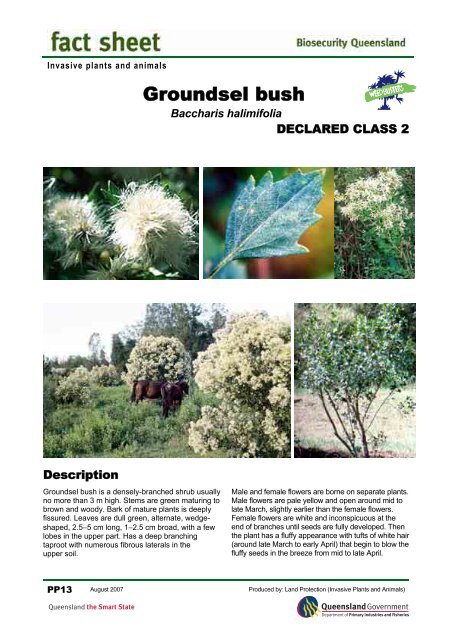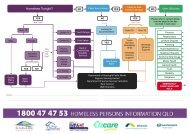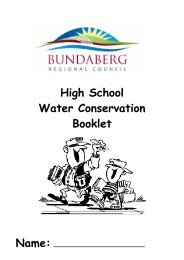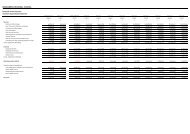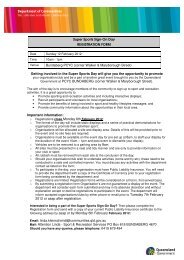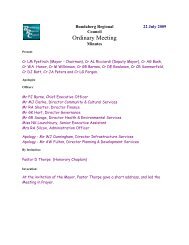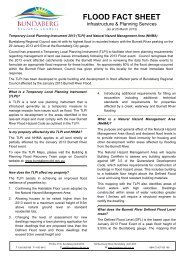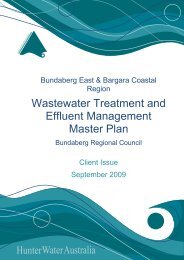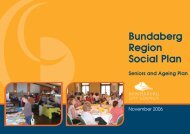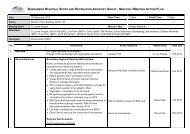Groundsel bush - Bundaberg Regional Council
Groundsel bush - Bundaberg Regional Council
Groundsel bush - Bundaberg Regional Council
You also want an ePaper? Increase the reach of your titles
YUMPU automatically turns print PDFs into web optimized ePapers that Google loves.
Invasive plants and animals<br />
<strong>Groundsel</strong> <strong>bush</strong><br />
Baccharis halimifolia<br />
DECLARED CLASS 2<br />
Description<br />
<strong>Groundsel</strong> <strong>bush</strong> is a densely-branched shrub usually<br />
no more than 3 m high. Stems are green maturing to<br />
brown and woody. Bark of mature plants is deeply<br />
fissured. Leaves are dull green, alternate, wedgeshaped,<br />
2.5−5 cm long, 1−2.5 cm broad, with a few<br />
lobes in the upper part. Has a deep branching<br />
taproot with numerous fibrous laterals in the<br />
upper soil.<br />
Male and female flowers are borne on separate plants.<br />
Male flowers are pale yellow and open around mid to<br />
late March, slightly earlier than the female flowers.<br />
Female flowers are white and inconspicuous at the<br />
end of branches until seeds are fully developed. Then<br />
the plant has a fluffy appearance with tufts of white hair<br />
(around late March to early April) that begin to blow the<br />
fluffy seeds in the breeze from mid to late April.<br />
PP13 August 2007 Produced by: Land Protection (Invasive Plants and Animals)<br />
Queensland the Smart State
Problem<br />
Economic<br />
<strong>Groundsel</strong> <strong>bush</strong> rapidly colonises disturbed areas,<br />
especially overgrazed pastures. It competes with<br />
pasture species for water and nutrients. It spreads<br />
rapidly from windbourne seed making clearing<br />
groundsel <strong>bush</strong> from paddocks a very time<br />
consuming and expensive task.<br />
Environmental<br />
In native Melaleuca wetlands, groundsel <strong>bush</strong> can<br />
form a dense understorey, suppressing growth of<br />
native sedges and interfering with the natural<br />
ecosystem. Fire management may play an important<br />
role in controlling groundsel <strong>bush</strong> in this<br />
environment although no formal research has yet<br />
been conducted.<br />
<strong>Groundsel</strong> <strong>bush</strong> can become abundant in the<br />
vegetation along watercourses and in coastal<br />
woodlands and forest areas if not controlled.<br />
Social<br />
The wind dispersed seed can be a nuisance in<br />
urban areas where it sticks to insect screens and<br />
germinates in home gardens. Urban problems<br />
include potential allergies caused by air-borne pollen<br />
and the air-borne seed 'fluff'.<br />
Habitat and distribution<br />
<strong>Groundsel</strong> <strong>bush</strong> is a native of Florida and coastal<br />
areas adjacent to the eastern side of the Gulf<br />
of Mexico.<br />
It was introduced into the Brisbane region as an<br />
ornamental plant in the year 1900 and has spread<br />
along the coastal areas of south-east Queensland<br />
(north to Miriam Vale Shire) and down the New<br />
South Wales coast. Scattered plants have occurred<br />
as far west as the Chinchilla region.<br />
<strong>Groundsel</strong> <strong>bush</strong> is a rapid coloniser of cleared,<br />
unused land and is particularly suited to moist<br />
gullies, salt marsh areas and wetlands. It also does<br />
well on high, cleared slopes.<br />
Most germination occurs in the autumn/winter<br />
period. Plants normally do not flower in the first year<br />
of growth. Two metre tall plants can produce half up<br />
to a million seeds.<br />
Seeds from mature plants drift in the breeze like<br />
thistle seeds, most falling within a few metres of the<br />
parent <strong>bush</strong>. Wind updraughts can carry seeds<br />
many kilometres.<br />
Seeds germinate readily with rainfall, however, if<br />
they become buried they can remain dormant for<br />
several years.<br />
Seeds are readily transported by wind, running<br />
water, vehicles and machinery. Soil disturbance in<br />
infested areas usually leads to substantial<br />
germination. Further infestation occurs unless the<br />
ground is sown to pasture or other competitive<br />
ground cover.<br />
Declaration details<br />
<strong>Groundsel</strong> <strong>bush</strong> is a declared Class 2 plant under<br />
the Land Protection (Pest and Stock Route<br />
Management) Act 2002. A Class 2 pest is one that<br />
has already spread over substantial areas of<br />
Queensland, but its impact is so serious that we<br />
need to try and control it and avoid further spread<br />
onto properties that are still free of the pest. By law,<br />
all landholders must try to keep their land free of<br />
Class 2 pests and it is an offence to keep or sell<br />
these pests without a permit. A Local Government<br />
may serve a notice upon a landholder requiring<br />
control of declared pests.<br />
Prevention<br />
The spread of groundsel <strong>bush</strong> threatens the<br />
sustainability of agriculture and other land uses.<br />
<strong>Groundsel</strong> <strong>bush</strong> can replace plants and destroy<br />
habitat for native wildlife.<br />
The best form of weed control is prevention. Always<br />
treat weed infestations when small, do not allow<br />
weeds to establish. Weed control is not cheap, but it<br />
is cheaper now than next year, or the year after.<br />
Proper management planning ensures you get value<br />
for each dollar spent.<br />
Look at your weed problem carefully. Can you<br />
realistically eradicate it? Or should you contain the<br />
weed to stop new infestations developing while you<br />
reduce existing ones? What are you required to do<br />
by legislation? How does weed control fit into your<br />
property management plan? What can you do to<br />
restore areas and prevent re-establishment?<br />
The best approach is usually to combine different<br />
methods. Control may include chemical,<br />
mechanical, fire and biological methods<br />
combined with land management changes. The<br />
control methods you choose should suit your<br />
particular situation.<br />
Management strategies<br />
In grazing situations good pasture management will<br />
greatly reduce groundsel <strong>bush</strong> invasions. Slashing,<br />
timely use of fertiliser and management of stocking<br />
rates can assist in control by maintaining a healthy<br />
pasture. Good pastures provide competition to limit<br />
re-invasion of groundsel <strong>bush</strong>es. Consult the<br />
Department of Primary Industries Pasture<br />
Agronomists on the best options for your property.<br />
For tall, dense infestations burning can reduce the<br />
amount of above-ground material (and even kill the<br />
odd plant) making it a lot easier to spray regrowth.<br />
Annual burning does not reduce existing plant<br />
numbers, but allows grasses to establish more<br />
quickly and outcompete groundsel <strong>bush</strong> seedlings.<br />
Regular slashing over a period of several years will<br />
result in a decreased level of infestation. In nongrazing<br />
situations re-forestation will eventually assist<br />
in control of groundsel <strong>bush</strong>. However, it is important<br />
to ensure that seed production is prevented while<br />
trees are establishing.<br />
Mechanical control<br />
Hand pull out small plants. Larger plants dig plants<br />
out or cut them off more than 10 cm below<br />
ground level.<br />
As groundsel <strong>bush</strong> is a perennial woody plant with<br />
underground growing buds, slashing or burning<br />
will rarely kill plants and such action will generally<br />
result in regrowth occurring. Therefore the regrowth<br />
will need to be promptly controlled.<br />
2
Biological control<br />
Biological control in the process of introducing the<br />
natural enemies of the weed to reduce their growth<br />
and seed production, or kill them. Biological control<br />
agents are specific to that weed, they will not harm<br />
native or economically important plants. Biological<br />
control agents are released at specific locations<br />
from which they will naturally start seeking out more<br />
areas of the targeted weed.<br />
Since the biological control program began for<br />
<strong>Groundsel</strong> <strong>bush</strong> in 1967 over thirty-five different<br />
insects have been tested but only six have become<br />
permanently established in the field.<br />
The six insects established are:<br />
1. Stem borer (Megacyllene mellyi). This beetle is<br />
restricted to areas adjacent to salt marshes<br />
where the sap flow in the host plant is lower.<br />
Newly hatched larvae are drowned by the<br />
heavier sap flow in plants growing in non-saline<br />
soils. Dense populations of this insect can<br />
reduce groundsel <strong>bush</strong> infestations in<br />
suitable habitats.<br />
2. Plume moth (Oidaematophorus balanotes). This<br />
insect is present in all areas. Damage is caused<br />
by larvae tunnelling in the stems and varies from<br />
severe dieback to death of individual branches.<br />
Populations of the moth appear to be restricted<br />
by ant predation on the eggs and young larvae.<br />
This in turn restricts plant damage.<br />
3. Gall-fly (Rhopalomyia californica). The larvae of<br />
this mosquito-like fly feed within development<br />
shoots and buds. Initially this insect caused<br />
heavy damage when it was released. However,<br />
soon after its release it was attacked by a small<br />
native wasp that drastically reduced gall<br />
numbers. Galls can always be found in low<br />
numbers, but occasionally higher numbers are<br />
found in patches. Overall damage to the plant<br />
is minimal.<br />
4. <strong>Groundsel</strong> <strong>bush</strong> leaf beetle (Trirhabda<br />
baccharidis). This beetle is restricted to similar<br />
habitats as the stem borer where the larvae can<br />
form suitable cocoons and pupate in the soil.<br />
Plants will be totally defoliated in autumn but can<br />
recover and are in full leaf next spring. In<br />
some years larvae severely damage the buds<br />
and flowers.<br />
5. Leaf skeletoniser (Aristotelia ivae). The larvae of<br />
this moth eat the soft leaf tissue leaving the<br />
skeletal woody veins. Though widespread,<br />
populations do not become large enough to<br />
cause significant damage. It is most commonly<br />
found in the spring on new leaves.<br />
6. Leaf miner (Buccalatrix iveila). The larvae of this<br />
small moth mine in the leaf blades and later<br />
skeletonise the leaves in a manner similar to<br />
Aristotelia. This insect is widespread within<br />
the range of groundsel <strong>bush</strong> and causes<br />
minor damage.<br />
Recent research has seen the move away from<br />
insect to plant disease biological control agents.<br />
Two diseases have been studied in Florida, USA.<br />
Experimental field releases of a rust fungus Puccinia<br />
evaders from Florida were commenced in 1998 and<br />
this pathogen is now established at several sites.<br />
7. <strong>Groundsel</strong> <strong>bush</strong> rust (Puccinia evadens). This<br />
pathogen acts as both a leaf and a stem<br />
parasite causing defoliation during summer and<br />
winter and stem dieback over summer. The<br />
infection process requires a moisture film on the<br />
leaf or stem surface. The dry spores are spread<br />
by wind.<br />
The presence of these biocontrol agents does<br />
not relieve landholders from their responsibility<br />
under Queensland legislation to control<br />
declared plants.<br />
Herbicide control<br />
Before using any herbicide always read the label<br />
carefully. All herbicides must be applied strictly in<br />
accordance with the directions on the label.<br />
Table 1 details the herbicides registered for<br />
groundsel <strong>bush</strong> control.<br />
Further information<br />
Further information is available from the vegetation<br />
management/weed control/environmental staff at<br />
your local government.<br />
flower<br />
0 7<br />
stem and leaves<br />
cm<br />
seed<br />
0 2<br />
cm<br />
3
TABLE 1 − HERBICIDES REGISTERED FOR THE CONTROL OF GROUNDSEL BUSH<br />
Situation Herbicide Rate Comments 1,2,3<br />
pastures; non-agricultural,<br />
commercial, industrial land;<br />
rights-of-way<br />
pastures; non-agricultural<br />
land<br />
pastures<br />
Commercial industrial land,<br />
pastures, rights-of-way<br />
irrigation channels/banks;<br />
non-agricultural commercial<br />
industrial land; home<br />
gardens, pastures;<br />
rights of way; forests<br />
commercial industrial land;<br />
pastures;<br />
rights-of-way<br />
commercial industrial land;<br />
pastures;<br />
rights-of-way; forests<br />
recreation commercial<br />
industrial land; pastures;<br />
rights-of-way; forests<br />
grass pasture<br />
pastures; forests;<br />
rights-of-way<br />
pastures<br />
2,4-D amine (500 g/L) 3.6-5.5 L/ha air - higher rate for <strong>bush</strong>es<br />
0.4 L/100 L high volume foliar spray<br />
300 mL/15 L cut stump<br />
1.2 L/15 L misting<br />
2,4-D acid 10 L/ha helicopter spraying<br />
33 mL/ 1 L kero or turps basal bark or cut stump<br />
100 mL/10 L knapsack foliar spray<br />
1 L/10 L sprinkler spray - 1 L/100 m 2<br />
2,4-D ester 800 g/L 0.25 L/ha Do not spray in "hazardous areas" - consult<br />
local DPI office for further information<br />
600 g/L 0.37 L/ha<br />
e.g. AF rubbervine spray 1 L/40 L diesel Basal bark or cut stump<br />
2,4-D sodium<br />
0.275 kg/100 L Spot spray<br />
e.g. Tornado DF<br />
glyphosate 5 - IPA 360 g/L 0.7-1 L/100 L handgun - high rate in winter<br />
100 - 150 mL/15 L knapsack foliar spray<br />
1:9 (2x2 mL dose/0.5 m splatter gun foliage<br />
<strong>bush</strong> height)<br />
picloram + 2,4-D<br />
0.65 L/100 L spot spray foliage<br />
e.g. Tordon 75-D R<br />
75 g + 300 g<br />
picloram + triclopyr<br />
0.25-0.35 L/100 L handgun foliage<br />
(premix)<br />
e.g. Grazon DS R *<br />
*Cannot be use in hazardous<br />
areas without a Department<br />
of Primary Industries Permit.<br />
2.5 L/100 L misting foliage<br />
30 mL/15 L knapsack foliage<br />
Access 1 L/60 L diesel basal bark or cut stump<br />
Triclopyr 600g/L<br />
e.g. Garlon 600®<br />
home garden packs<br />
e.g. Defender<br />
Chemspray<br />
(Garden King)<br />
dicamba + MCPA<br />
(premix) (e.g. Banuel M R )<br />
0.16-0.32 L/100 L water overall spray foliage<br />
1 L/120 L diesel basal bark or cut stump<br />
25-50 mL/15 L knapsack foliage<br />
50 g/L overall spray foliage<br />
120 g/L basal bark or cut stump<br />
0.1-0.2 L/5 L water knapsack foliage<br />
0.1 L/0.5 L kerosene basal bark or cut stump<br />
2.8-4 L/ha<br />
0.19-0.27 L/100 L<br />
60 mL/15 L knapsack foliage<br />
Clopyralid<br />
0.33-0.5 L/100 L handgun foliage<br />
e.g. Lontrel R<br />
Tebuthiuron 200g/kg<br />
e.g. Graslan®<br />
1 gm/m 2 hand application (use restrictions apply)<br />
Notes:<br />
1. Pasture legumes are susceptible to these herbicides.<br />
2. Cut stump treatments – cut as close to ground as possible and apply mixture immediately (within 15 seconds).<br />
3. Basal bark treatments – paint/spray 25 cm band around base of each stem.<br />
4. Do not apply during summer or winter drought.<br />
5. Glyphosate will kill pasture species.<br />
Fact sheets are available from DPI&F service centres and the DPI&F Information Centre phone (13 25 23). Check our web site<br />
to ensure you have the latest version of this fact sheet. The control methods referred to in this Pest Fact should be<br />
used in accordance with the restrictions (federal and state legislation and local government laws) directly or indirectly related to each<br />
control method. These restrictions may prevent the utilisation of one or more of the methods referred to, depending on individual<br />
circumstances. While every care is taken to ensure the accuracy of this information, the Department of Primary Industries and Fisheries<br />
does not invite reliance upon it, nor accept responsibility for any loss or damage caused by actions based on it.<br />
© The State of Queensland (Department of Primary Industries and Fisheries) 2007


